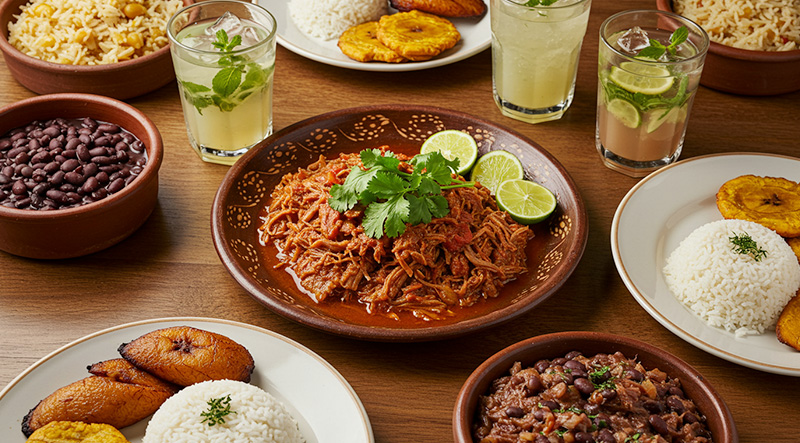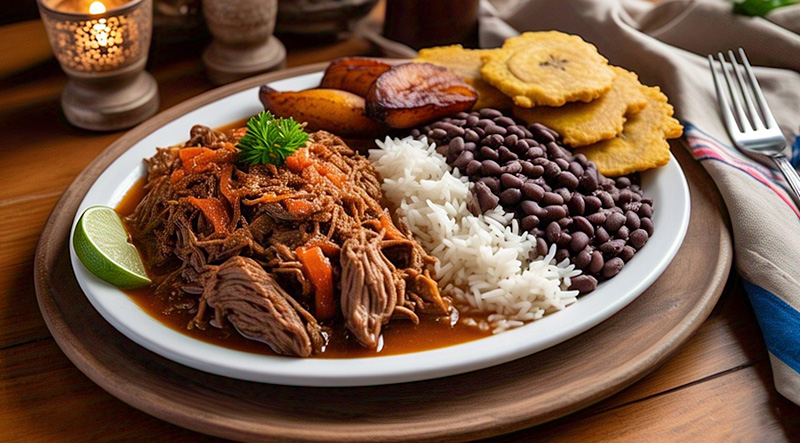Ropa Vieja, Cuba's iconic national dish, is a flavorful masterpiece that captures the essence of Cuban comfort food. Imagine tender, shredded beef simmered in a zesty tomato-based sauce, infused with sweet bell peppers, onions, and a medley of spices that dance on the palate. This hearty dish, served with a side of fluffy rice, black beans, and crispy plantains, is a feast that not only delights the taste buds but also tells a rich story of Cuba’s culinary roots. Every bite is a savory celebration of Cuban tradition, offering a perfect blend of bold, rich, and vibrant flavors. Read More...
The History of Ropa Vieja – Cuba’s Iconic National Dish:
Ropa Vieja, Cuba’s beloved national dish, is much more than just a meal—it’s a culinary journey steeped in history, culture, and tradition. Known for its rich flavors, tender beef, and colorful presentation, Ropa Vieja has earned its place as a symbol of Cuban cuisine. The dish has deep roots in Cuban history, with its origins dating back to the island’s colonial period, when Spain’s influence introduced new flavors, techniques, and ingredients to the region.
Origins of Ropa Vieja:
The name “Ropa Vieja” translates to “old clothes” in Spanish, a fitting description for the dish’s shredded beef, which looks remarkably like torn rags or clothing. The story of Ropa Vieja traces back to the 16th century, when Spanish settlers brought cattle to Cuba. With the abundance of beef, many dishes were created, but Ropa Vieja became a favorite among Cubans due to its hearty and satisfying nature. While the exact origins are debated, one popular legend suggests that Ropa Vieja was first created by Spanish settlers who, after a long day, had to make do with leftover ingredients. They would slow-cook the beef, turning it into a flavorful stew with vegetables and spices, creating what would become the dish we recognize today.
A Dish Born of Tradition and Resourcefulness:
Ropa Vieja became an essential part of Cuban cuisine due to its simple, yet robust ingredients. The dish is traditionally made with flank steak or brisket, simmered slowly in a sauce made from tomatoes, onions, bell peppers, garlic, olives, and capers, along with a variety of spices like cumin and oregano. The cooking process allows the beef to become fall-apart tender, absorbing the savory flavors of the sauce. Over time, Ropa Vieja grew to embody the soul of Cuban home cooking, relying on the island’s rich agricultural resources, such as beef, tomatoes, and bell peppers.
This dish was also a symbol of Cuban ingenuity—transforming inexpensive cuts of beef into something delicious and flavorful. The introduction of rice, black beans, and fried plantains alongside Ropa Vieja helped round out the meal, offering a perfect balance of flavors and textures.
Ropa Vieja and Cuban National Identity:
As Cuba underwent political and cultural shifts throughout the centuries, Ropa Vieja remained a constant presence in Cuban homes and restaurants. It became a dish not just for everyday meals, but also for festive occasions, family gatherings, and special celebrations. Its status as Cuba’s national dish was cemented as it became synonymous with Cuban hospitality and warmth.
Ropa Vieja’s enduring popularity also reflects Cuba’s diverse cultural influences. The dish combines elements from the island’s Spanish, African, and indigenous Taino heritage. While the basic recipe has remained largely the same, regional variations exist, with different regions of Cuba adding their unique twists—such as the inclusion of more exotic spices or vegetables.
Ropa Vieja in Modern Cuba:
Today, Ropa Vieja continues to be enjoyed by Cubans at home and abroad. It remains a staple in Cuban restaurants, from street vendors to fine dining establishments. The dish is often served as part of a classic Cuban “comida criolla” or “traditional Cuban food” plate, accompanied by side dishes like congrí (rice and beans), tostones (fried plantains), and salad. For many Cubans living abroad, particularly in places like Miami and New York, Ropa Vieja provides a comforting taste of home and a link to their heritage.
As a dish that blends history, tradition, and taste, Ropa Vieja is not just about food—it’s a symbol of Cuban culture itself. Each bite of this savory dish connects people to the island’s past, where resourcefulness and bold flavors gave birth to one of the most beloved dishes in Cuban cuisine.
Conclusion:
Ropa Vieja, with its tender beef and flavorful sauce, has traveled through time and across generations to become a cornerstone of Cuban cuisine. From its humble origins to its status as a national treasure, it represents the heart and soul of Cuban cooking. Whether served in a bustling Havana café or in a home kitchen abroad, Ropa Vieja remains a dish that brings people together, offering a taste of Cuba’s rich history and vibrant culture with every delicious bite.
Prepare the Beef:
Sauté the Vegetables
Simmer the Sauce:

Add the Shredded Beef:

Taste and Adjust:

Serve:
Tips for the Perfect Ropa Vieja:
Enjoy your Ropa Vieja, a true taste of Cuban comfort food!
The preparation time for Ropa Vieja is approximately 20 minutes, including the time to slice the vegetables and shred the beef. Cooking time takes about 2 hours: 1.5 to 2 hours to simmer the beef until tender, followed by an additional 30-40 minutes to sauté the vegetables, simmer the sauce, and combine everything. Overall, you’ll need about 2.5 to 3 hours from start to finish, but much of this time is passive, allowing the beef to slow-cook and absorb the rich flavors of the sauce.
A single serving of Ropa Vieja, based on the recipe provided, contains approximately 350-450 calories. This estimate includes the shredded beef in a rich tomato-based sauce with vegetables and spices, served with a side of white rice, black beans, and fried plantains. The exact calorie count may vary depending on portion size and specific ingredients used, such as the optional raisins or wine. The combination of protein from the beef, carbohydrates from the rice and plantains, and healthy fats from olive oil makes it a balanced and satisfying dish.







